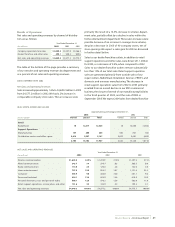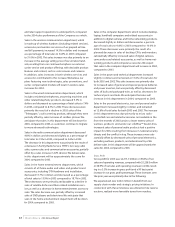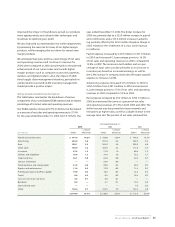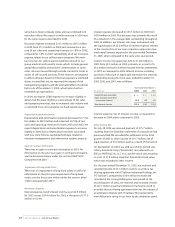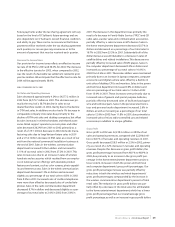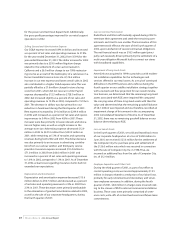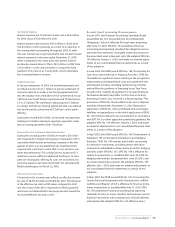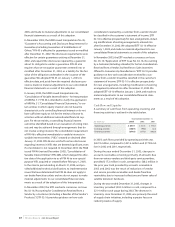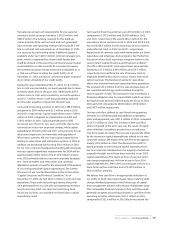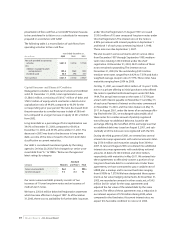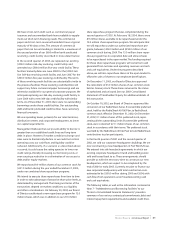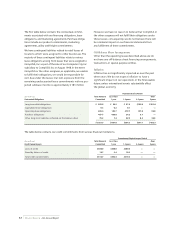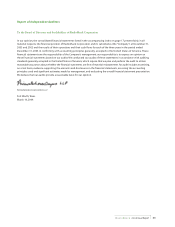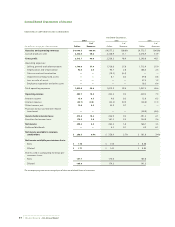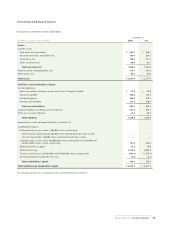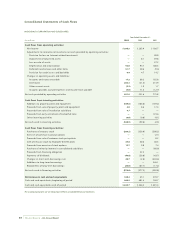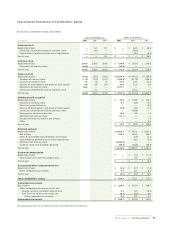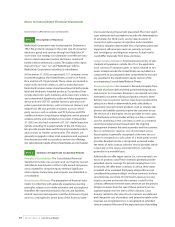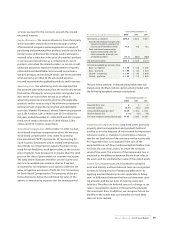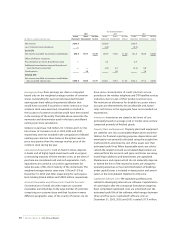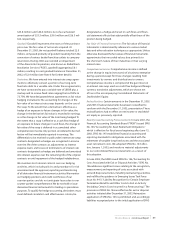Radio Shack 2003 Annual Report Download - page 33
Download and view the complete annual report
Please find page 33 of the 2003 Radio Shack annual report below. You can navigate through the pages in the report by either clicking on the pages listed below, or by using the keyword search tool below to find specific information within the annual report.
RADIOSHACK 2003 Annual Report 31
We have short-term debt such as commercial paper
issuances and uncommitted bank loans available to supple-
ment our short-term financing needs.The commercial
paper and short-term seasonal bank debt have a typical
maturity of 90 days or less.The amount of commercial
paper that can be outstanding is limited to a maximum of
the unused portion of our $600 million bank syndicated
revolving credit facility described in more detail below.
In the second quarter of 2003, we replaced our existing
$300.0 million 364-day revolving credit facility and
amended our $300.0 million five-year credit facility. These
facilities’maturity dates are June 2004 for the $300.0 mil-
lion 364-day revolving credit facility and June 2007 for the
$300.0 million five-year revolving credit facility.The terms
of these revolving credit facilities are substantially similar to
the previous facilities.These revolving credit facilities will
support any future commercial paper borrowings and are
otherwise available for our general corporate purposes.We
anticipate replacing our 364-day revolving credit facility in
June 2004 with a new 364-day credit facility with similar
terms. As of December 31, 2003, there were no outstanding
borrowings under these credit facilities. Our outstanding
debt and bank syndicated credit facilities have customary
financial covenants.
We use operating leases, primarily for our retail locations,
distribution centers and corporate headquarters, to lower
our capital requirements.
Management believes that our present ability to borrow is
greater than our established credit lines and long-term
debt in place. However, if market conditions change and
sales were to dramatically decline or we could not control
operating costs, our cash flows and liquidity could be
reduced. Additionally, if a scenario as described above
occurred, it could cause the rating agencies to lower our
credit ratings, thereby increasing our borrowing costs, or
even causing a reduction in or elimination of our access to
debt and/or equity markets.
We repurchased 9.9 million shares of our common stock for
$251.0 million during the year ended December 31, 2003,
under our combined share repurchase programs.
We intend to execute share repurchases from time to time
in order to take advantage of attractive share price levels, as
determined by management.The timing and terms of the
transactions depend on market conditions, our liquidity
and other considerations. On February 20, 2003, our Board
of Directors authorized a new repurchase program for 15.0
million shares, which was in addition to our 25.0 million
share repurchase program that was completed during the
second quarter of 2003. At February 18, 2004, there were
8.9 million shares available to be repurchased under the
15.0 million share repurchase program. We anticipate that
we will repurchase, under our authorized repurchase pro-
grams, between $200.0 million and $250.0 million of our
common stock during 2004.The 15.0 million share repur-
chase program has no expiration date and allows shares
to be repurchased in the open market.The funding required
for these share repurchase programs will come from cash
generated from net sales and operating revenues and cash
and cash equivalents.Under the programs described
above, we will also repurchase shares in the open market to
offset the sales of shares to our employee benefit plans.
On December 11, 2003, our Board of Directors approved
the retirement of 45.0 million shares of our common stock
held as treasury stock.These shares returned to the status
of authorized and unissued. See our 2003 Consolidated
Statement of Stockholders’Equity for additional details of
this transaction.
On October 10, 2002, our Board of Directors approved the
conversion of our RadioShack Series B convertible preferred
stock, held by the RadioShack 401(k) Plan, to RadioShack
common stock effective December 31, 2002. On December
31, 2002, 0.1 million shares of this preferred stock, repre-
senting all the outstanding Series B convertible preferred
stock, were converted to 5.1 million shares of our common
stock in accordance with their terms.The preferred stock
was held by the RadioShack 401(k) Plan to fund RadioShack
contributions to plan participants.
In the fourth quarter of 2001 and the second quarter of
2002, we sold our corporate headquarters buildings.We are
now constructing a new headquarters in Fort Worth, Texas.
We entered into sale-leaseback agreements in which our
existing corporate headquarters’land and buildings were
sold and leased back to us.These arrangements should
provide us with the necessary time to construct our new
headquarters, which we expect to be completed by the
end of 2004 or early 2005. Currently, we plan to finance our
new corporate headquarters,with total construction costs
estimated to be $200.0 million during 2003 and 2004, with
cash flows from operations and, if needed, existing cash
and cash equivalents.
The following tables, as well as the information contained in
Note 7 - “Indebtedness and Borrowing Facilities”to our
“Notes to Consolidated Financial Statements,”provide a
summary of our various contractual commitments, debt and
interest repayment requirements, and available credit lines.


